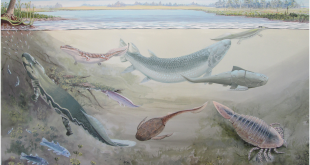Living Agnathan fishes possess conical, rasping tooth-like structures made of keratin, the same structural protein found in human hair and nails, on their tongue, rather than enamel covered, bony teeth typical of other vertebrates. The lamprey also has similar teeth around its mouth. They also have no identifiable esophagus or …
Read More »Lead
Osmoregulation in Chondrichthyes
Blood ionic composition in marine elasmobranchs and holocephalans is some what higher than in teleosts, but its osmolarity is very much higher, close to that of seawater. This is because the blood contains, in addition to the usual ions, large amounts of low-molecular weight nitrogenous solutes, chiefly urea. First found …
Read More »Food Choices of Fish
But optimal foraging strategies may not remain identical throughout an organism’s lifespan and many species exhibit a trophic ontogeny or shift in food types and sizes, or feeding styles at different stages in their life cycle. These are necessitated by the fishes own increase in size, by morphological developments or …
Read More »The Osmotic Problem of Fishes
Different fishes live in waters from almost distilled purity, to hypersaline ponds where they have difficulty keeping below the surface. The ability to live in such different waters is remarkable enough for stenohaline fish which do not move from a single environment, but, perhaps more striking, there are a good …
Read More »Circulation in Fishes: Primary and Secondary
The oxygen acquired (from water or air), and the carbon dioxide excreted at the gills, have to be transported around the body by the circulation of the blood. In fishes using the gills as a gas exchanger, the primary circulation is single, blood leaves the heart to pass first through …
Read More »Respiration in Hagfish and Lampreys
Hagfish In hagfishes, unidirectional water flow through the serial muscular gill pouches is chiefly brought about by rolling and unrolling of velar folds. These lie in a chamber developed from the naso-hypophyseal tract and are operated by a complex set of muscles inserting onto cartilages of the neurocranium. Peristaltic contractions …
Read More »Origin of Freshwater Fishes
The variety of freshwater fishes is striking, for they show radiations into different habitats with some of the most extraordinary adaptations of all fishes. The African mormyrids and the South American gymnotids, for example, have independently evolved amazingly specialized electrical signaling systems for use in crowded and turbid waters, and …
Read More »Freshwater Fishes: Diversity
Diversity of Freshwater Fishes Despite representing only a miniscule (0.0093% according to Horn, 1972) part of the world’s aquatic habitat, freshwaters contain a disproportionate number of species (over 40%, again according to Horn, 1972). Unlike the oceans, which constitute broad, uninterrupted expanses of water, freshwater habitats tend to be much …
Read More »Marine Fishes: The Open Ocean
Epipelagic Fishes The open ocean beyond the continental shelf covers nearly two-thirds of the surface of the Earth, and some 2500 species are found there, distributed vertically from the uppermost waters to the greatest depths, about half being benthic, half pelagic. Near the surface is the euphotic zone, where light …
Read More »Marine Fishes: Coastal Region and Shallow Seas
Warm-water Fishes By far the greatest number (80%) of the 10 000 or so species of fishes in shallow seas live in warm temperate or tropical waters, most associated with coral reefs and atolls, in waters where mean temperatures during the coldest part of the year do not fall below …
Read More » EazyBio: Educate, Elevate, Empower EazyBio: Educate, Elevate, Empower
EazyBio: Educate, Elevate, Empower EazyBio: Educate, Elevate, Empower









